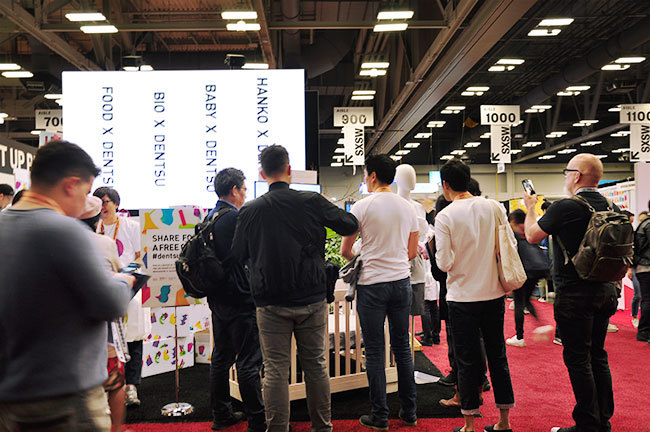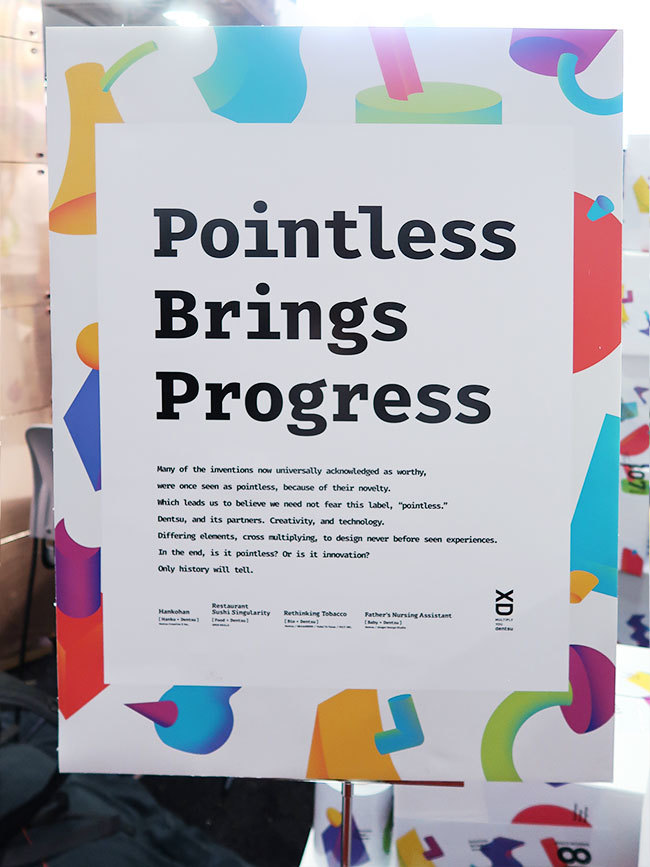Every spring, the "South by Southwest" (SXSW) festival takes place in the United States. This event draws numerous companies and creators from around the world, showcasing forward-thinking works in music, film, and interactive media. The Interactive section, where new technologies and business ideas converge, is particularly renowned for unveiling services like Twitter and Airbnb that later became global hits, capturing significant attention. This year, too, various "seeds" of business were announced.
Dentsu Inc. exhibited a total of four projects this year. This series focuses on the creators responsible for these projects and their production, delving into each individual's story.
For the first installment, we speak with Yasuharu Sasaki (Executive Creative Director, Creative Planning Division 4), who oversaw Dentsu Inc.'s overall SXSW participation, about the overall concept and significance of exhibiting.

Yasuharu Sasaki (Dentsu Inc., Creative Planning Division 4)
Things whose value is not yet clear will spark future transformation
—First, could you tell us about this year's exhibition concept?
This time, we adopted the exhibition concept "Pointless Brings Progress." This means that things or ideas that seem pointless at first glance, precisely because they are too novel, are the ones that drive future innovation.
Invention is built upon such historical accumulation, and ideas that open new futures may lie beyond our current metrics. Therefore, even if an idea is hard to appreciate now, we decided to showcase anything with potential or the creator's passion.
This also serves as an antithesis to the pursuit of "efficiency." As digital technology advances, especially in advertising, the mainstream approach has become to segment targets and create expressions guaranteed to yield results. This is wonderful and a natural progression for improving advertising quality.
However, when looking far into the distant future, I can't help but feel some unease. Will such efficient methods truly give birth to innovations that drastically change the future, or ideas that transform society? In a sense, might we end up confined to expressions and ideas that fall within the realm of what's calculable? Considering this, I've always believed it's best to have both: the efficient and its opposite.
What might be dismissed as "potentially useless" can actually spark major transformation. Once released into the world, it can generate unexpected popularity. That is the true power of creative ideas. That's precisely why we're testing such ideas at SXSW. That meaning is embedded in this concept.
The four works introduced this time are from Dentsu Inc.'s cross-functional internal organization, the "Digital Creative Center," a volunteer team within the company, and Dentsu Creative X. This is the second year in a row we've exhibited with this lineup. Last year's participation stemmed partly from the scarcity of platforms to showcase ideas with grand visions for the future. In daily work, even when good ideas emerge, opportunities to present them are rare. In that sense, SXSW was an excellent venue and we believed it would boost creators' motivation.
Amidst SXSW's evolution, four works envisioning the future
—Regarding the concept, why were these four projects selected?
While all these projects utilize cutting-edge technology, the focus isn't solely on showcasing the technology itself. Rather, they reveal the seeds of larger visions and ideas—the futures and societies these technologies could enable.
SXSW became famous as a festival showcasing the latest technologies, but in recent years, it has entered a different phase. Rather than just presenting new tech to gain recognition, it's increasingly becoming a place to pose the question: what kind of future will emerge when these technologies become widespread in society? What kind of society can we imagine?
Indeed, the organizers themselves cite "distrust of digital" as one of the defining trends of the show, signaling a shift in focus. New technologies themselves are no longer novel; we've reached a state of saturation. Precisely because of this, the emphasis has shifted to exploring how these technologies will coexist with people. For instance, what kind of society can we envision when technologies like AI and autonomous driving become deeply integrated? The trend is now toward depicting these ideas.
Within this context, we too exhibited works centered not on the technology itself, but on the society and vision emerging from it.
While each project lead will detail their work in this series, take "SUSHI SINGULARITY"—a project digitizing and datafying "food." It redefines dining concepts, like enabling personalized sushi to be recreated anywhere globally using specialized machines.
While this project is returning from last year, we deliberately chose to showcase its ongoing "seed." We believed showing the continuous refinement of its vision would better convey the depth of its concept.
The other three are debuting this year, yet they connect to our future vision. "FATHER'S NURSING ASSISTANT" is a device designed so "fathers can also" breastfeed and put babies to sleep. It aims not only to solve gender and diversity issues through technology but also to spark discussions about parenting approaches.
"RETHINKING TOBACCO" uses new biotechnology to advance agriculture and attempt to solve the food crisis. While the technology itself comes from a venture company, we joined the project and developed its presentation. "HANKOHAN" proposes a new form of communication using the traditional Japanese "hanko" (seal).
"The ability to create stories" is also cultivated on this stage.
—How was the response to your exhibits?
Both were received positively, and we're satisfied. Visitors actively shared their opinions and spoke candidly, which provided significant learning.

Moving forward, we hope more people will raise their hands saying, "I want to do this too" as we continue this initiative. While expressions and methods that deliver definite results are important, I believe a creator's true strength lies in achieving significant outcomes through unexpected, out-of-the-box ideas that no one else would think of. We want to cherish the SXSW stage as an opportunity to generate bold ideas.
Furthermore, with today's ability to visualize data in minute detail, making any choice requires clear, numerical justification for why that option was selected. However, while advertising expected to yield short-term results is easily explained by data, wildly unconventional ideas or concepts for the future are difficult to articulate with data. That's when the question arises: why pursue it? Why will it change people's behavior? Storytelling and context-building will be essential for creators moving forward. I believe SXSW offers a valuable opportunity to cultivate that ability.
http://dentsusxsw.com/jp/





